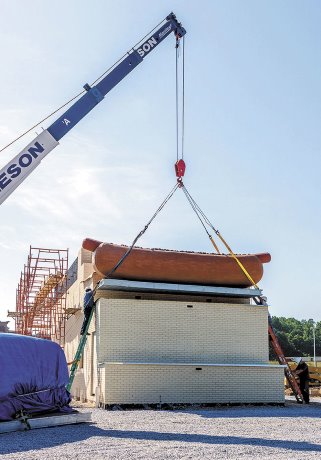Pal’s Sudden Service has been a household name in northeast Tennessee and southwestern Virginia for 60 years, where the chain of 29 restaurants serves traditional fast food. And who needs a menu, when the roof of each restaurant features a giant fibreglass hot dog, hamburger, sack of fries and an iced tea? All but one restaurant, that is.
In Pal’s newest location in Johnson City, Tenn., local zoning regulations required a brick exterior and no exception would be made for fibreglass food. Unwilling to forego the restaurant’s signature style, chain president and CEO Thom Crosby doubled down on the requirement, ordering his fast food icons to be reproduced in brick.
It’s no wonder. The giant food has a pedigree, with the original design sketched on a napkin by artist Tony Barone, a contemporary of pop artists Andy Warhol and Roy Lichtenstein.
"Unfortunately, these changes increased the cost of building at this new location and meant that instead of using local workers to craft our traditional giant hot dog and burger, we had to spend those dollars in Nebraska," says Crosby.
"That’s where we found a supplier who was able to make our giant trademark images from brick."
That supplier was Jay Tschetter, president of Images in Brick in Lincoln. He’s spent decades in both masonry and art, at one point specializing in scrimshaw—engraving in bone and ancient ivory. Eventually, he realized he could combine those passions into a single craft. Much of his work involves creation of detailed brick murals and sculptures, rendered in classical style. His breakthrough mural installation, Iron Horse Legacy, was completed in 1990 and features an image of the first locomotive that pulled into Lincoln.
"This was a bit of a switch for me," he says. "We decided that the best way to move forward was to use one of their typical fibreglass hot dogs and hamburgers and use it as a sub-structure. They put a special reinforced frame into the hot dog, calculating the weight I would need to add in thin brick, and then filled it with foam to stiffen it."
Tschetter says he consulted with a friendly mechanical engineer who explained that fibreglass expands and contracts according to temperature. Between zero and 100 Fahrenheit, the 26-foot frankfurter could grow as much as an inch longer and a half-inch wider.
"That meant I had to build it with two expansion joints," he says. "I experimented with wetting and curving thin-cut brick but it would just spring back when it dried. I decided to go with straight brick and urethane glue, which was highly compatible with fibreglass and apply the brick sections in mosaic style."
The hotdog was the most challenging item on the menu. Weighing in at 2,500 lbs., Tschetter struggled with the massive model until an ingenious friend helped to design a rotisserie-style sling that allowed him to rotate the dog 90 degrees in either direction.
He used local company Yankee Hill Brick to supply the brick required to complete the project. Only the bricks used to make pickles needed to be coloured.
"I had to carefully use shims to place each brick tile and glue it into place," he says. "I cut up hundreds and hundreds of shims to make it look good. The ends of the hot dog took the longest to create. I just followed the contours and in some cases built it up an inch so it would round off correctly. I even had to sculpt brick chili for the hot dog topping. I did the whole job myself over a period of about six months and enjoyed doing it. It was like a meditation."
Tschetter allowed the hot dog to bake in 100-degree weather before shipping it back to Tennessee—now 3,000 lbs. heavier, calculating the weight of brick and grout.
All told, bricking the hotdog and hamburger added about US$250,000 to the cost of building the restaurant.
"They flew me down to inspect the hotdog and watch it being installed at the restaurant by crane," says Tschetter.
"And after working on the chili dog for six months, I finally tasted one."



Recent Comments
comments for this post are closed